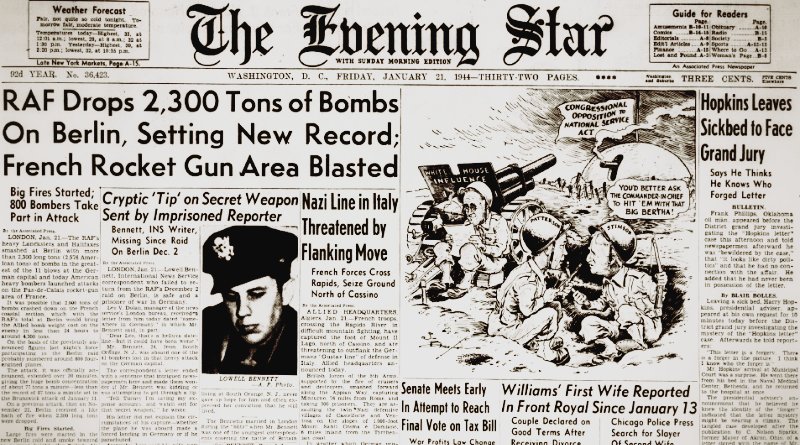World War II Chronicle: January 21, 1944
Click here for TODAY’S NEWSPAPER
A gaunt Tom Harmon is pictured on page four after returning to friendly lines. The former Michigan football sensation was shot down over China and spent a month making his way back last month… George Fielding Eliot discusses the Eastern Front on page eight…
Sports is on page 12, which features a Grantland Rice column.
Roving Reporter by Ernie Pyle
IN ITALY — Although our dive-bomber pilots are largely spared the worry of German fighter planes, they are plenty concerned over the anti-aircraft flak and other ground fire. The German ack-ack over the front lines is smothering. Here’s the way it works:
Suppose our planes make a big circle back of the German lines in order to approach the target from a new angle, which they do every day.
Well, the Germans may pick them up 40 miles from their target. Our men have to fly every inch of that through heavy flak.
It’s a game of wits. The pilots above and the gunners on the ground know each other’s actions so well by now that it’s almost impossible for either side to do anything new. If our pilots do think of a new evasive maneuver one day,the Germans have it figured out by the next; and vice versa, if the German gunners shoot a different pattern one day, our pilots have it figured out before the next mission.
The planes have to fly in constant “evasive action,” which means going right, going left, going up, going down, all the time they are over enemy territory. if they flew in a straight line for as long as 15 seconds, the Germans would pick them off.
A pilot sits up there and figures this way: “Right now they’ve got a bearing on me. In a certain number of seconds they’ll shoot and in a few more seconds the shell will be up here. It’s up to me to be somewhere else then.”
But he also knows that the Germans know he will turn, and that consequently they will send up shells to one side or the other or above or below his current position.
Thus he must never make exactly the same move two days in a row. By constantly turning, climbing, ducking, he makes a calculated hit almost impossible. His worst danger is just flying by chance right into a shell burst.
I asked on of the pilots, “Why wouldn’t it be a good idea to fool them about once every two weeks by just flying straight ahead for a while.”
He said, “Because they’ve got that figured out too. They always keep the air dead ahead of you full of shells, just in case.”
Pilots have some freakish escapes from shell blasts. Several have had shells explode within a foot or two of their plane without getting hurt. They say it sounds as if you’d fired off a dozen shot-guns in the cockpit. The concussion tosses the plane around like a cork, yet often these close bursts don’t damage the plane at all.
A friend of mine, Lieut. Jimmy Groswold, of Los Angeles, was thrown violently into a dive by a shell that must have exploded within a foot of the tail of his plane, yet there wasn’t a mark on it when he got home.
The German gunners are canny. For instance, on a bad day when there is a high layer of clouds with just a few holes through which the bombers might dive, they’ll fill up those holes with flak when they hear planes overhead. Sometimes the smoke of their gunfire forms a think layer through which the planes must dive, and there is a hole or two in this layer they’ll put up a few shells and stop up the holes.
But it isn’t the heavy flak up above or the medium flak on the way down that worries the pilots as much as the small-arms fire from the ground after they’ve finished their dive.
If you’d ever been in a raid on either side, you’d understand. I know that when German planes come over our lines the whole valley for miles and miles become one vast fountain of flying lead with bullets going up by the thousands. It’s actually like a water spray, filling the air as far as you can see.
Our dive-bomb pilots have to fly through this every day. They “hit the deck” the minute they’ve pulled out of their bombing dive, for it’s harder to see a plane that is close to the ground. Also, when they’re almost down to earth the Germans firing at them may shoot their own troops — but when that doesn’t stop them, they keep banging away.
The pilots say it’s the accidental bullets they’re most afraid of. They say that nine times out of ten it’s some goof standing out in the field shooting wilding into the air that gets a hit.
When a big push is on, our dive-bomber pilots sometimes have to go through this sort of thing three times in a single day. So you see that, although they live well when at home base, they aren’t on any picnic when they go out to work.
Evening star. (Washington, D.C.), 21 January 1944. Chronicling America: Historic American Newspapers. Lib. of Congress.
https://chroniclingamerica.loc.gov/lccn/sn83045462/1944-01-21/ed-1/
